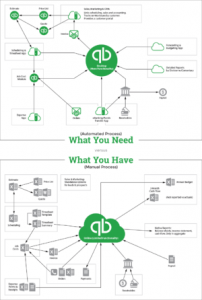No one process will address all situations, but the 80-20 rule applies: 80% of your work is routine, and 20% are one-offs.
Automated voice attendants are great, if not universally loved, examples of this. Good ones are set up to quickly take the caller past the most likely reason for the call (“Press 1 for Password Reset”) or perhaps the most important (“… to report a lost or stolen card”).
Your finance department processes will likely follow the same 80/20 rule:
- Eighty percent of your tasks are likely to be routine and low-value; invoicing is a good example.
- Twenty percent are likely to be more complicated, such as budgeting, and often add more value to the business.
What should you improve?
Start by being Effective: do the right things. For example, are you including all the information the customer needs to reduce the number of concerns about their bills?
Follow that with being Efficient: do things right. This can include Accuracy: processing the invoice correctly – doing it right the first time – so you don’t have to find time to do it over. Following closely on Accuracy’s heels is Speed – making the process faster in addition to the time savings from more Effective and Accurate processes.
Imagine improving your invoicing system with any or all of these changes:
- you bill at the point of sale (Speed)
- you collect the cash immediately (Speed);
- your customers have no questions about what or why they have been charged (Effectiveness and Accuracy)
Your customers will be happier, and you’ll collect the cash faster. Those would be great on their own, but you’re also saving processing time – which probably means you can devote that time to improving other processes.
The upshot is that you should focus first on improving the routine tasks, so you have more time for the more complicated stuff, which is more likely to be value add. If the complicated stuff is process improvement in other areas, then you’re starting a snowball effect.
Profit Breakthrough:
Keep It Simple. Look at your processes for Efficiency and Effectiveness. First, cut out the number of steps (the Method). A checklist is a great place to start. Next, consider automating what’s left (the Tools). Automating a mistake prone process only increases the number of errors.
Consider the 80-20 Rule. Automating the routine gives you more time to focus on the value-add.
Your new process should Do It Right The First Time; it will save you three times as much effort, to say nothing of the knock-on costs.
Approach the design and the implementation as a whole, but try to do both in bite-sized chunks.

